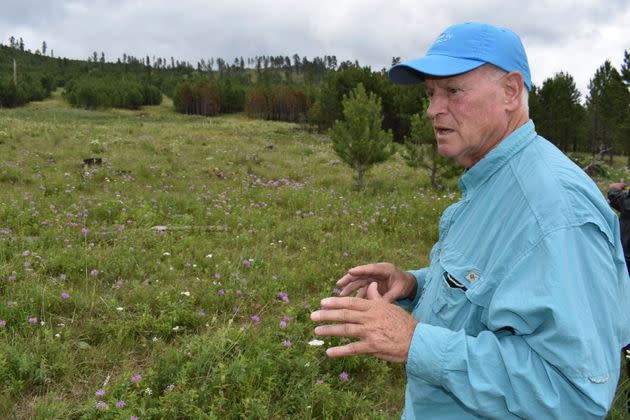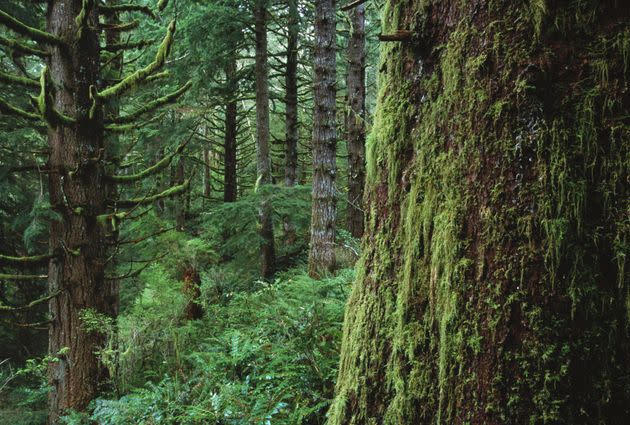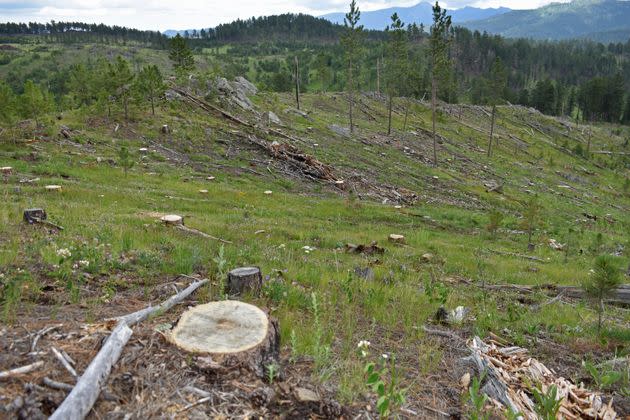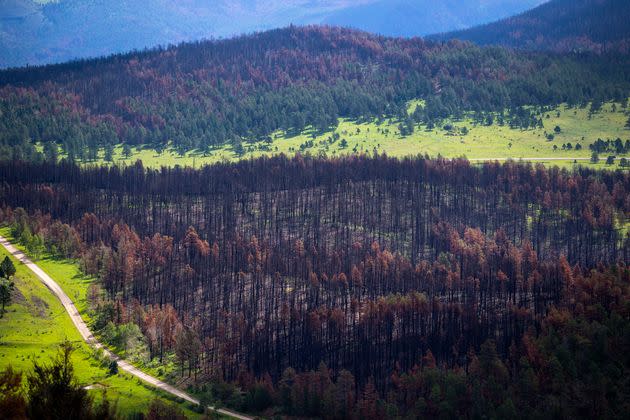Biden’s Forest Service Is Dragging Its Feet On Protecting Ancient Trees From Logging
- Oops!Something went wrong.Please try again later.

On Earth Day last year, President Joe Biden signed an executive order aimed at protecting and restoring mature and old-growth forests on federal lands across the country — one that many environmentaliststook as a sign that the administration could move to halt logging of ancient trees that help slow the effects of climate change.
The order acknowledged the “irreplaceable role” forests play in sequestering planet-warming greenhouse gasses and tasked the nation’s two largest federal land managers, the Bureau of Land Management and the U.S. Forest Service, with inventorying the nation’s remaining carbon-rich forests and then crafting rules to better conserve them in the face of mounting climate change impacts.
“Old-growth” forests, sometimes referred to as primary forests, are typically defined as those at least 150 years old and largely undisturbed by human activity, whereas “mature” forests are decades old but haven’t reached the old-growth stage. Together, these ecosystems form a key natural climate solution.
Early in his tenure, Biden found himself on shakyground with green groups over the administration’s lack of commitment to protect these carbon hotspots. The executive order reinvigorated environmentalists and forest advocates.
But a little more than a year later, some of those same forest experts have soured. They say the Forest Service ― an agency within the Department of Agriculture established in 1905 primarily to ensure a steady supply of timber — isn’t taking the matter seriously enough, leaving the door open for the timber industry to keep chopping down mature and old-growth forests.
Steve Pedery, conservation director at environmental organization Oregon Wild, said Biden’s order was a big deal and challenged the Forest Service to reinvent itself — from an agency that largely prioritizes timber production to one that manages forested lands for carbon storage, wildlife and clean water, with timber as a byproduct. But he says it is clear the Forest Service is dragging its feet on proposing a rule, nevermind one that confronts the ongoing threat of logging to older forests. He compared what the agency has done so far to a child being told to clean their room and instead stuffing all their belongings in a drawer and folding their arms.
“We are trying desperately to make sure the White House stays involved,” he said. “I think if this gets delegated down in a time where it’s perfectly reasonable the administration has its focus on a lot of other things, we’ll see the Forest Service either run out the clock on it or come up with something that says, ‘Logging is the answer. What was the question?’”
It is the latest example of what Pedery and others see as an entrenched, pro-logging mindset within the Forest Service — and the Biden administration’s hesitance to push the agency to abandon its old ways, despite publicly proclaiming its support for protecting mature and old-growth forests. Part of the problem, they argue, is the agency’s position that logging such forests is key to protecting them from wildfires, which are growing increasingly devastating as climate change fuels heat waves and drought.
After decades of intensive logging, few primary forests remain in the continental United States. Those that do are almost exclusively on federal lands, mostly in the West. The recent federal inventory, mandated by Biden’s executive order and released in April, found there are approximately 32.7 million acres of old-growth and 80.1 million acres of mature forest across the federal estate — a combined area slightly larger than California. About 92 million of those are on Forest Service land.
More than 130 scientists, including Mike Dombeck, chief of the Forest Service in Bill Clinton’s administration, have called on Biden to end old-growth logging on public lands.
“Older forests provide the most above-ground carbon storage potential on Earth, with mature forests and larger trees driving most accumulation of forest carbon in the critical next few decades,” they wrote in a letter to Biden the day before he signed the executive order. “Left vulnerable to logging, though, they cannot fulfill these vital functions.”
‘Loath To Mention The Word Logging’
In recent months, BLM and the Forest Service each took a step toward fulfilling the White House directive — actions that green groups widely celebrated as long-overdue moves toward balancing conservation with drilling, mining, logging and other developmenton public lands.
In March, the BLM unveiled a draft rule that seeks to place conservation “on equal footing” with energy development and other traditional uses, including through issuing “conservation leases” to promote land protection and ecosystem restoration. In announcing the agency’s action, Interior Secretary Deb Haaland said that “for too long, land management planning has been dominated by extractive industries.”
The Forest Service took a more modest action, publishing an advanced notice of proposed rulemaking, or ANPR, in April that seeks public input on how the agency should “adapt current policies to protect, conserve, and manage national forests and grasslands for climate resilience.” An ANPR is a preliminary step before an agency decides whether to move forward with a proposed rule.
That notice stresses the importance of mature and old-growth trees, including their resilience to climate change and their “role in contributing to nature-based climate solutions by storing large amounts of carbon and increasing biodiversity.” It also softly confronts past agency missteps, including “non-climate informed timber harvest” and decades of aggressive fire suppression that left many forests choked with excessive fuels.
But it stopped short of recognizing logging as an ongoing threat to primary forests or proposing to safeguard ancient trees from harvest. Instead, the document focuses on other threats to forest ecosystems, including wildfire and disease outbreaks, and promotes timber harvesting as a tool to “improve stand health and resilience” amid climate effects and other stressors.
“Logging” does not appear once in the agency’s ANPR. Similarly, the only mention of logging in Biden’s executive order is a section on halting deforestation abroad. It also does not specifically call for protecting old trees from being felled at home.

Jim Furnish, a former deputy chief of the Forest Service in the Clinton administration, has closely monitored the agency’s actions in the wake of Biden’s executive order on protecting mature and old-growth forests. He has grown increasingly disappointed with its resistance to change.
“I have found it unsettling but not surprising that the Forest Service has been loath to mention the word ‘logging,’” said Furnish, who has become an outspoken critic of his former agency’s management approach since retiring in 2002. “Forest Service logging is one of the acknowledged threats to mature and old-growth forest on national lands. We’ve challenged them several times about being more forthcoming and candid, and they just brush it off. They just will not do it.”
“The Forest Service has kind of blithely allowed local national forest units to just keep on cutting mature and old-growth forests as if the executive order did not exist,” he added.
There are many actions the Forest Service could have taken in the year since Biden’s executive order to show it was serious about protecting these forests from a threat it has the most control over, Furnish said, from suspending all timber sales that propose harvesting mature and old-growth trees to stipulating that all such projects must be reviewed and approved by Forest Service Chief Randy Moore.
“They’ve done nothing of the kind,” he said.
One exception is the so-called “Flat Country” project, in Oregon’s Willamette National Forest, which would have allowed for about 2,000 acres of mature and old-growth Douglas fir and western hemlock to be cut down. In January, the Forest Service withdrew its decision to greenlight the controversial project, noting at the time that “some parts of it may be incongruent with recent directives and climate-related plans concerning conservation of mature and old-growth forests and carbon stewardship.” The withdrawal came on the heels of a pressure campaign from environmental groups that included protesters occupying the forest in an attempt to block the project from moving ahead.
The Biden administration also reversed a Trump-era rule that lifted Clinton-era logging restrictions across 9 million acres of Alaska’s Tongass National Forest, the world’s largest intact temperate rainforest.
Meanwhile, many other mature and old-growth logging projects and timber sales have moved forward under Biden’s watch.
Some forest ecologists and conservationists view the situation not so much as a disconnect between the White House and the Forest Service, but between the administration and the growing body of science showing old-growth forests’ resistance to fire and their capacity for storing massive amounts of carbon in trees and soil.
“The Forest Service deserves the criticism. Let’s be clear, they don’t have to propose these giant logging projects,” said Chad Hanson, forest ecologist at the Earth Island Institute’s John Muir Project. “But the Biden administration has the ultimate responsibility to tell the Forest Service to shift direction, to shift away from 20th century logging policies and move into a 21st century approach to our national forests, which would emphasize biodiversity, forest carbon storage, recreation and recreation jobs.”
To date, there is no sign that the White House has made that demand.
“That’s the problem,” Hanson said. “Don’t tell me mature and old-growth forests are important and now let’s do a lot more logging in them.”
Furnish agrees the White House must do more to force the Forest Service’s hand.
“Is the White House … going to tell the Forest Service what to do? Or are they simply going to ask the Forest Service what to do?” Furnish said. “Everything I’ve seen to date implies they are simply asking the Forest Service what to do. And given the Forest Service’s track record, particularly during the Trump administration, it is not surprising that they’re kind of continuing as if nothing has changed, until and unless some subsequent action is taken.”

Former U.S. Forest Service Deputy Chief Jim Furnish tours a recent logging project in South Dakota's Black Hills National Forest on July 14, 2021.
Furnish still talks to current Forest Service officials, and he told HuffPost that he’s heard directly from Chris Swanston, the Forest Service climate adviser and acting director of the agency’s Office of Sustainability and Climate, that the agency’s leadership is less enthusiastic than the White House about the need for a climate resilience rulemaking — and that there is no guarantee the Forest Service will follow through on proposing one.
The Forest Service did not make Swanston available for an interview. In an email statement, USDA spokesperson Larry Moore said “it is premature to speculate on timing for any potential future regulatory actions” as federal law requires the agency to consider all comments submitted during the rulemaking process.
“The Forest Service is responding to the direction in the executive orders and Secretarial Memo with data-informed tools, strategies, policy recommendations, and systems for accountability for fire and climate resilience, climate adaptation, reforestation, ecosystem and watershed restoration, ecosystem services, mature and old growth forests, and carbon stewardship, as well as related investments in community engagement, partnerships, collaboration and equity,” Moore said.
Asked about Furnish’s account of his conversation with Swanston, Moore said it would be “inappropriate for us to comment on third-party conversations and rumors.”
Earlier this month, the Forest Service extended the public comment period on the ANPR from 60 to 90 days. The deadline is now July 20.
Furnish said there doesn’t appear to be any urgency on the Forest Service’s part to get a rule across the finish line, let alone to do so before the end of Biden’s term in office. Not doing so could sink the prospects of a rule ever being put in place.
“I know enough about politics to know that if the Republicans take the White House, this whole thing is going to be buried immediately,” he said.
The White House told HuffPost that federal agencies “are working swiftly ― guided by public input and science ― to restore and conserve America’s forests, including our mature and old-growth forests, and to meet our ambitious climate goals.”
“The Forest Service and Bureau of Land Management recently completed two critical first steps in that work: creating a first-ever nationwide definition of what mature and old growth forests are and completing a nationwide inventory,” a spokesperson for the White House’s Council on Environmental Quality said via email. “The next step is gathering input from the public, Tribal Nations, states, and stakeholders on what policy and management changes should be made to better conserve and restore these forests, including harnessing their potential to help tackle the climate crisis.”
The White House did not comment on whether it has encountered resistance within the Forest Service.
A Model For Change
In the summer of 1991, the Siuslaw National Forest on Oregon’s central coast found itself backed into a corner. For decades, Forest Service managers there had allowed for intensive logging of mature and old-growth trees — vital habitat for the majestic northern spotted owl.
That year, a federal judge in Seattle banned all logging in spotted owl habitat, concluding that the scale of timber harvest under the George H.W. Bush administration threatened to drive the species to extinction. The owl came under federal protection one year earlier when it was listed as a threatened species under the Endangered Species Act.
The court ruling and the Northwest Forest Plan, adopted by the Clinton administration in 1994 to help protect old-growth trees and threatened wildlife across millions of forested acres in the Pacific Northwest, ultimately brought about a seismic shift in the Siuslaw, which at the time was among the most heavily logged forests in the nation. Management that was focused squarely on the economic value of harvesting giant trees was ultimately replaced with restoration forestry and ecosystem-wide stewardship.
It was Furnish who spearheaded that shift as supervisor of the Siuslaw.
“I took the aim of trying to grow mature and old-growth timber seriously, and I felt that one of the big liabilities we had was the past 40 years of clear-cut logging,” Furnish said. “We very ambitiously set out to thin a lot of the old clear-cut units. And we did so. And they’ve been doing that for the last 30-something years.”

Oregon's Siuslaw National Forest is home to old-growth Sitka spruce and western hemlock.
Furnish was widely ridiculed at the time; however, the benefits proved enormous. The national forest is now richer in mature and old-growth trees. Populations of at-risk species — the northern spotted owl, coho salmon and marbled murrelet — rebounded. And by focusing on thinning unnatural, monoculture tree plantations that were planted after extensive clear-cutting ― a method that involves cutting down all or most of the trees in a selected area — the forest has continued to be a source of timber.
“What we didn’t know at the time is the benefits that would redound to forest carbon and forest sequestration,” Furnish said. “We didn’t think about it, we didn’t talk about it, we didn’t consider it. It was not even in our mind.”
A 2018 report from the Oregon Global Warming Commission found that since the early 1990s, forests in Oregon have transitioned from being a likely net source of carbon to a major sink.
“It’s not surprising that when you stopped the real aggressive clear-cut logging of mature and old-growth forests in the Northwest, they started to grow. They started to grow like crazy and began laying on ton after ton after ton of carbon,” Furnish said. “It served to be a real boon to the climate change issue and illustrative of what forests can do, in a sense, when they are unleashed.”
Forest advocates see the Siuslaw as a model that can and should take hold across the Forest Service.
“Thirty years later, everyone celebrates the Siuslaw as the wonderful win-win — meets its timber quota, doesn’t log old growth, coho salmon are recovering, everyone loves it,” yet the agency has resisted imposing that example on forested land elsewhere, Pedery said.
“It’s still very much ‘we are forest managers, we get out there and engineer the kinds of forests we want.’ And now, all of the money and political direction is to engineer the forests for fire. And that’s what they’re doing,” he said. “This rulemaking, they’re doing it begrudgingly, but definitely there’s a view, I think, from agency leadership that what they’re being asked to do is at odds with that baked-in desire to get out there with some chainsaws and fix some stuff.”
In A Smoky Fog
The White House has repeatedly vowed to do more to combat deforestation and better preserve intact forests as part of its broader climate agenda. Meanwhile, federal agencies are advancing more than 20 logging projects targeting tens of thousands of acres of ancient trees — often under the umbrella of wildfire mitigation and resilience.
Those in the pipeline include the Bitterroot Front Project, in Montana’s Bitterroot National Forest, where 55,000 acres of trees, including mature and old growth, are on the chopping block. The project is billed as a “fuels reduction, vegetation management, and forest health improvement” effort.
In Montana’s Kootenai National Forest, the Black Ram project would allow for nearly 4,000 acres of western larch, ponderosa pine and western white pine, including some 500 acres of mature and old-growth trees, to be logged. In its decision to approve the project last year, the Forest Service wrote that harvesting the timber is “the most effective strategy in increasing resilience.”
The Upper Cheat River Project, in West Virginia’s Monongahela National Forest, targets 3,400 acres of mature forest, including stands that are more than 100 years old.

A stump-covered hillside in the Black Hills National Forest on July 14, 2021. In a report earlier that year, Forest Service scientists concluded that current logging practices in the Black Hills are unsustainable and that the harvest must be cut by 50% or more.
Critics charge that one of the main roadblocks to the Forest Service embracing preservation of remaining ancient trees is its narrow focus on combating wildland fire.
In January 2022, Agricultural Secretary Tom Vilsack and Moore, head of the Forest Service, unveiled a 10-year strategy for confronting America’s wildfire crisis through increased logging, forest “thinning” and prescribed fires to reduce high fuel loads. It calls for “forest health treatments” on an additional 50 million acres of forested land, both public and private, across the nation over the next 10 years — more than double current levels.
More recently, Vilsack and Haaland issued a joint memo to federal agencies outlining goals for managing fire this year. The document highlights several drivers of extreme wildland fire, including climate change, drought, extreme heat and expanding development in areas prone to fire, but makes no mention of fire suppression.
The amount of money spent on fighting fires in the U.S. has exploded in recent decades. And with the passage of the Infrastructure Investment and Jobs Act in 2021 and last year’s Inflation Reduction Act ― Biden’s signature climate law ― Congress injected a combined $5 billion into reducing the risk of wildfire.
With that money now in hand, the Forest Service is under intense pressure to deliver, Furnish said.
“I almost think they are viewing the executive order as a problem that’s getting in the way of their fire response, as opposed to an opportunity to really consider recasting the future of the agency around climate change, carbon storage, mature and old-growth forests and some of those values,” he said. “I sense that the Forest Service sees these goals of fire risk reduction and responding proactively to the executive order as mutually exclusive. I disagree with that premise entirely.”
In response to HuffPost’s inquiry, which included a question about whether the Forest Service views fire as a bigger threat to mature forests than logging, Moore pointed to an NPR story about how the recent fires in California killed nearly one-fifth of remaining giant sequoias.
“The increased risk of carbon loss through natural and human-caused disturbances, such as wildfires and insect epidemics, can jeopardize carbon storage and other ecosystem services,” he said. “For this reason, the USDA Forest Service understands that wildfire and other climate-related stressors are a chief threat to old-growth and mature stands on national forests and grasslands.”
Furnish, Hanson and Dominick DellaSala, chief scientist at forest advocacy group Wild Heritage, accuse the agency of cherry-picking science that supports increased logging.
The ANPR “did not go far enough in stating the irreplaceable biodiversity and carbon values of [mature and old growth], did not cite the importance of carbon accumulation rates that increase with tree sizes, nor the outsized role of large tree and older forests as carbon reservoirs that represents best available science,” DellaSala wrote in draft comments to the agency, which he shared with HuffPost.
Hanson highlighted research that shows harvesting mature trees in an effort to save them from fire actuallyemits roughly three times more carbon per acre than wildfire alone and that thinning and other fuel reduction activities can at times increasefire severity by altering a forest’s microclimate.

Pine trees remain blackened in an area of the Carson National Forest in northern New Mexico after a fire in April 2022.
Furnish acknowledges that wildfire is a complex threat. He doesn’t see the solution as black or white. Thinning of smaller trees, especially when followed by prescribed fire, is widely embraced as a proven tool for reducing fuel loads and preventing severe wildfire. But he said prevailing Forest Service dogma is that they view any prohibition on logging primary forests as a fundamental hurdle to reducing wildfire risk.
“I simply don’t think they see a way through if they don’t have free and ready access to chainsaws cutting down a lot of mature and old-growth trees to reduce the density of a lot of these stands,” he said.
That tunnel vision, he said, is clearest when visiting logging projects and timber sales in places like the Green Mountain National Forest in Vermont, the Black Hills National Forest in South Dakota and Apache–Sitgreaves National Forest in Arizona.
In 2021, Furnish toured an area of the Black Hills where loggers were allowed to conduct “overstory removal” — cutting down nearly every mature tree — across about 3,000 acres that was heavily thinned 15 years ago to mitigate an infestation of mountain pine beetles. Rob Hoelscher, district ranger for the Forest Service’s Hell Canyon District, told the Hill City Prevailer newspaper in South Dakota that harvesting the older trees was necessary to provide younger trees the space and sunshine to thrive.
Furnish called the logging project “deplorable” and condemned the Forest Service’s justification.
“To me it is patently obvious that field managers — from forest supervisors, rangers, foresters on down — they simply don’t get climate change, forest carbon, mature and old growth,” he said. “Any evidence that the Forest Service is taking that seriously on the ground is completely lacking.”
